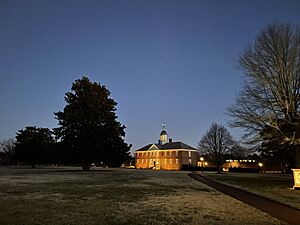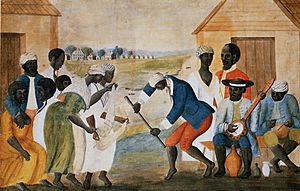Abby Aldrich Rockefeller Folk Art Museum facts for kids

Exterior of museum, 2020
|
|
| Established | 1957 |
|---|---|
| Location | Williamsburg, Virginia |
The Abby Aldrich Rockefeller Folk Art Museum (AARFAM) is a very important museum in the United States. It was the first museum in the country, and the oldest one still open, that focuses on American folk art. Folk art is art made by ordinary people, often without formal training.
The museum is located near Colonial Williamsburg, Virginia. It started with a collection of art given by Abby Aldrich Rockefeller. Her husband, John D. Rockefeller Jr., who helped create Colonial Williamsburg, also provided money for the museum.
Abby Rockefeller helped people see folk art as a valuable part of American art. Before her efforts, many thought of it as just simple crafts. The museum first opened in May 1957. It has grown and moved several times to hold its increasing collection. Abby Rockefeller's original gift of 424 art pieces has grown to more than 7,000 folk art items. These pieces date from the 1720s to today. A new expansion at its current location opened in 2019.
The museum has changed its name a few times. It was first called the Abby Aldrich Rockefeller Folk Art Collection. In 1977, it became the Abby Aldrich Rockefeller Folk Art Center. Then, in 2000, it got its current name, Abby Aldrich Rockefeller Folk Art Museum. Today, it shares a building with the DeWitt Wallace Decorative Arts Museum. Together, they are known as the Art Museums of Colonial Williamsburg.
Contents
History of the Museum
How the Collection Started
Abby Aldrich Rockefeller loved collecting American folk art. She got advice from experts and art dealers. In 1932, she secretly loaned some of her folk art to an exhibition at the Museum of Modern Art in New York. This show was called American Folk Art: The Art of the Common Man in America, 1750–1900. It helped people see folk art as an important part of American history and culture.
In 1935, Rockefeller loaned some of her collection to the Ludwell–Paradise House in Williamsburg. Four years later, she officially gave the collection to Colonial Williamsburg. It stayed at the Ludwell-Paradise House until 1956.
Building the First Museum
Abby Aldrich Rockefeller passed away in 1948. A few years later, her husband announced he would provide money for a new museum in Williamsburg. In 1956, their son, David Rockefeller, added more folk art objects to the collection. These were pieces his mother had given to other museums. The collection remained open at the Ludwell-Paradise House until January 1, 1956.
The Rockefellers worked with Nina Fletcher Little, an expert in American decorative arts. She suggested making the new museum feel like a home. She also did the first research on the collection.
The Abby Aldrich Rockefeller Folk Art Collection opened in May 1957. It was in a new brick building designed in the old Georgian/Federal style. It had a lovely oval garden. This building was just outside the historic area of Colonial Williamsburg. The Ludwell-Paradise House, where the collection used to be, became a private home.
Museum Expansions and Moves
In 1992, the museum added a large, new section. It was a 19,000-square-foot brick building with a beautiful garden and fountain. This addition was designed by architects Roche-Dinkeloo.
In 2007, the AARFAM moved from its original building. It joined the DeWitt Wallace Decorative Arts Museum nearby. This new location gave the folk art collection 10,400 square feet of space. It had 11 galleries for displaying art. The original building and its additions then became part of the Spa of Colonial Williamsburg.
In 2014, the Colonial Williamsburg Foundation announced a big expansion for the museum. This $40 million addition started construction in April 2017. It opened in 2019. This new wing is 65,000 square feet and has a new, easier-to-access entrance.
What's in the Collection?
The museum's main collection started with the 424 objects Abby Rockefeller collected between 1929 and 1942. Today, the museum has grown to include more than 3,000 objects.
Soon after it opened, the museum added works from other collectors. These included pieces from J. Stuart Halladay, Herrell Thomas, Holger Cahill, Edith Gregor Halpert, and John Law Robertson.
Now, the museum has many different types of folk art. You can see:
- Portraits (paintings of people)
- Southern and African American folk art
- Sculptures
- Fraktur (colorful Pennsylvania German drawings)
- Textiles (art made from fabric)
The museum also features works by famous folk artists. Some of these artists include Eddie Arning, Wilhelm Schimmel, Erastus Salisbury Field, Edward Hicks, Lewis Miller, Albert Hoffman, Louis Joseph Bahin, and Ammi Phillips. The museum has also shown works by 18th and 19th-century painters like Zedekiah Belknapp, James Sanforth Elsworth, and Asabel Lynde Powers.
One special piece in the museum is an 18th-century watercolor painting called The Old Plantation. It was painted by John Rose from South Carolina.


